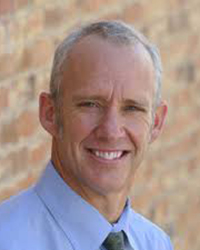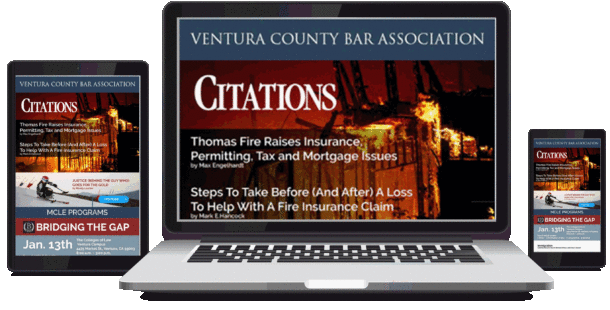
JANUARY – TWO THOUSAND EIGHTEEN
VCBA MISSION STATEMENT
To promote legal excellence, high ethical standards and professional conduct in the practice of law; to improve access to legal services for all people in Ventura County; and to work to improve the administration of justice.
Thomas Fire Raises Insurance, Permitting, Tax and Mortgage Issues
by Max Engelhardt
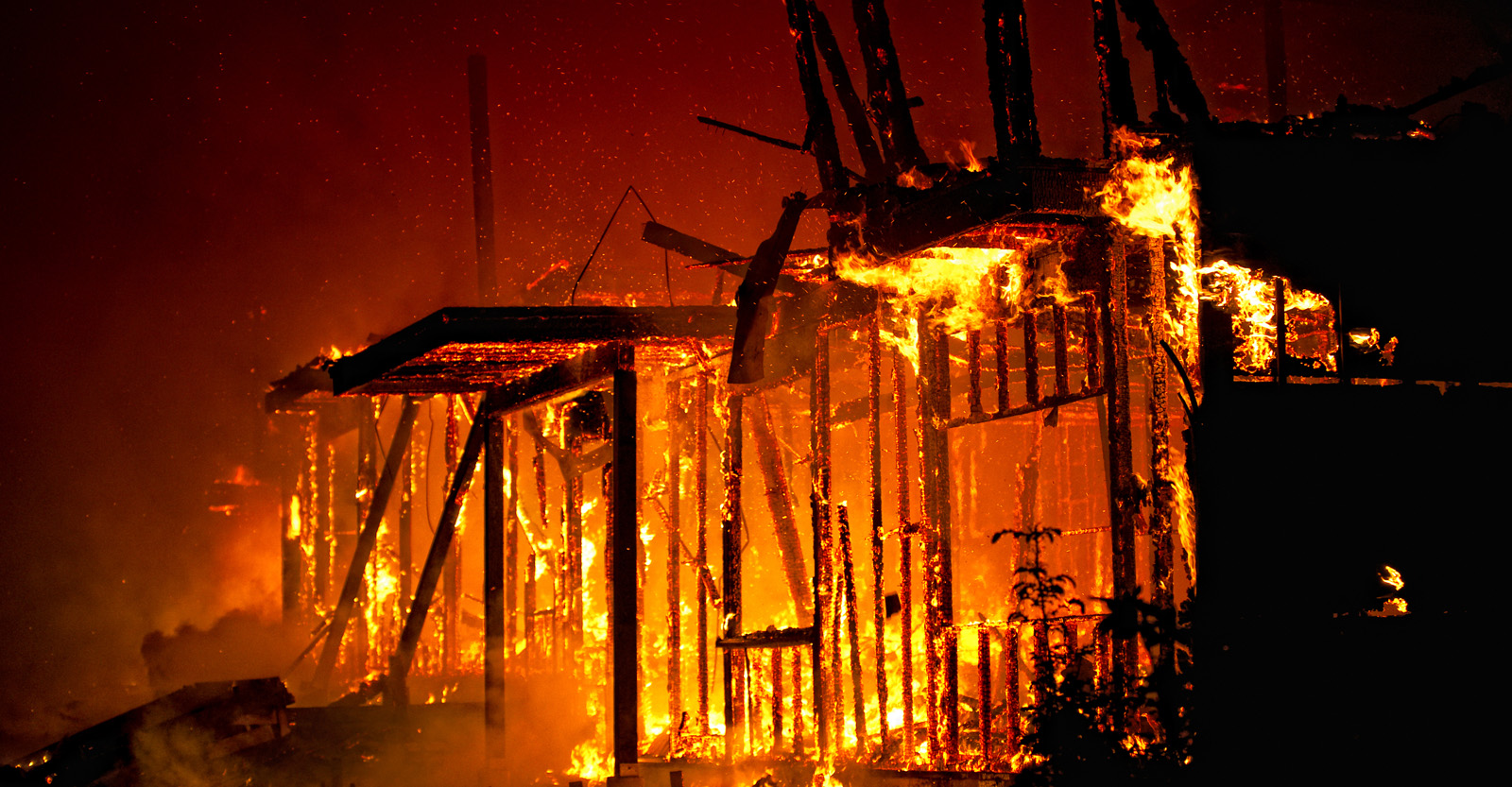
CITATIONS EDITORIAL BOARD
Managing Editor
Wendy C. Lascher
Assistant Editor
Cari Ann Potts
Assistant Editor
Heather Deffense
Publisher, CEO
Steve Henderson
Creative
J.P. McWaters
Alice Arnold
Rachel Coleman
Jonathan Gunderson
Karen B. Darnall
Rachael J.Kimball
Panda L. Kroll
Carol Mack
Michael L. McQueen
Rabiah A. Rahman
Lauren E. Sims
Michael R. Sment
Kathleen J. Smith
Al Vargas
CITATIONS is published monthly by the Ventura County Bar Association. Editorial content and policy are solely the responsibility of the Ventura County Bar Association.
Submit all editorial matters to:
CITATIONS
1050 S. Kimball
Ventura, CA 93004
t: 805.659.6800
f: 805.659.6818
wlascher@fcoplaw.com
| MARK KIRWIN | PRESIDENT’S MESSAGE | |
| LETTER TO THE EDITOR | ||
| MARK E. HANCOCK | STEPS TO TAKE BEFORE (AND AFTER) A LOSS TO HELP WITH A FIRE INSURANCE CLAIM |
|
| JUDGE FRED BYSSHE | RENAISSANCE JUDGE: MEMORIES OF JUDGE WILLIAM PECK | |
| WENDY LASCHER | JUSTICE (BEHIND THE GUY WHO) GOES FOR THE GOLD | |
| GREG JOHNSON | INTERNSHIP OPENS CAREER DOOR | |
| STEVE HENDERSON | EXEC’S DOT…DOT…DOT… |
PRESIDENT’S MESSAGE
by Mark Kirwin
How do I write a President’s message when my friends, colleagues, members of the judiciary and so many other people in our county, and Santa Barbara County, have had their homes destroyed by fire? It is my hope and prayer that when you read this article, most fire refugees will have found a new home that is safe and secure, and are able to put food on the table without financial worry.
For the last nine days, we have all been doing everything we can to help those in need. I have met over a dozen renters who lost everything and had no insurance. I have talked to friends and colleagues who lost all, but still are able to smile, expressing gratitude that they were not hurt.
The stories are tough to forget when I go to sleep at night, especially of the people who have no insurance. For instance, the woman who only last year lost her husband to cancer while eight months pregnant, with a toddler in tow, who loaded her car as the children slept, and then drove away from their house as the fire came up the canyon, only to realize that she left all of her husband’s things behind.
Or the parents of the young athlete who used to run for Foothill Tech High School. Her coach told me that if there was ever anyone to help, it would be her family. Why? Because the coach had dedicated an annual award in her name for a member of the cross-country team who was the most positive and gave back to the team and community during the season.
Or the artist who was only able to save his paintings from the fire, but none of his other design pieces that he used to generate income.
Or the recent MBA graduate who started a new window cleaning business and had just purchased over $20,000 of tools, only to find out that the storage container he had recently bought to store the tools had a wood floor and caught on fire, destroying his wares.
Or the man who had disabling arthritis for the last fourteen years who had just started a new job and had a house where his children could stay with him on the weekends, which went up in flames. His smile was strong, he was positive, but his eyes told the deeper story of his inner suffering – trying to find a place where his girls could stay with him once again on
the weekends.
Then there are some of my good friends, including my partner, who keep such a positive attitude about the loss that I find it hard to match that strength and conviction that everything will be OK.
During those first few days of the fire we held community meetings to coordinate relief efforts, sharing information between CALFIRE, our fire and police departments, faith-based groups, philanthropy clubs, city officials and concerned citizens. We learned that: the fire burned that first night at a furious pace, a football field a minute; 27,000 people were evacuated in the first hour of the fire; approximately 869 structures were destroyed within the first week; the total cost to fight the fire after seven days was $38,369,058 and 1,400 structures were without gas and the water boil order was still in effect for most of the north end of the city off the Avenue; mobile generators were installed at backcountry microwave towers; well over 231,700 acres had burned, with small percentages of containment as the winds constantly shifted, gaining new force as the fire moved north toward Carpinteria; and approximately 6,946 public safety and emergency personnel, 912 fire engines, 27 helicopters, 50 water tenders, 125 hand crews, 67 dozers; and 4,000 firefighters (now over 8,500) were deployed to fight the fires. It is hard to imagine what the final numbers will be when this catastrophe is finally contained.
I cannot write an article about the Thomas Fire without giving praise and sincere gratitude to all the firefighters who risked their lives to save as much of our city as they could. I was walking last week past some fire trucks parked down by the Pier, and realized that the fire crew was from Montana. I gave them a big thumbs up and a smile. So, thank you Montana firefighters, and thank you to all of your firefighter brothers and sisters from all over California and the western states who have helped us in our greatest time of need. And thank you to all our local restaurants who continued to feed our first responders free of charge. And thank you to all the government officials, private citizens, faith leaders and social philanthropy clubs who have worked non-stop to help our city and county recover.
And, most of all, thank you for the smiles of encouragement and positivity from all those who lost their homes. Your courage is amazing!
Mark Kirwin, 2018 Ventura County Bar President, is a civil litigator at Kirwin & Francis, LLP, and is Director of the Kirwin International Relief Foundation.
LETTER TO THE EDITOR
Hello, friends.
We lost our home in the fire. Right after the mandatory evacuation was lifted on our neighborhood, my husband and I went home to sift through the rubble. During that time, at least three people drove by to check out what was going on. I felt two parts circus sideshow, one part science experiment, and wholly displaced and vulnerable. We lost everything and were in our masks, hazard suits and on our hands and knees trying to find something, anything, in the rubble, and people drove by to take a look at our sorrow.
We don’t want pity, but I will be the first to tell you that it felt awful. Please take that for what it’s worth. Let’s please come together and be neighbors and friends at this time, be sensitive to what we each experience and say, and, most of all, please just be kind.
I don’t know whether this will be helpful to those who consider visiting the destruction, and I can’t blame people for being curious about the extent of the damage (which is tremendous). All I know is this: whoever chooses to do so should be made aware of what it feels like to have strangers witness you in your most vulnerable, naked and grieving state. I hope this comment will help to bring awareness.
#VenturaStrong
Given the subject of this letter and the author’s request, CITATIONS has agreed to print the letter without identifying the author.
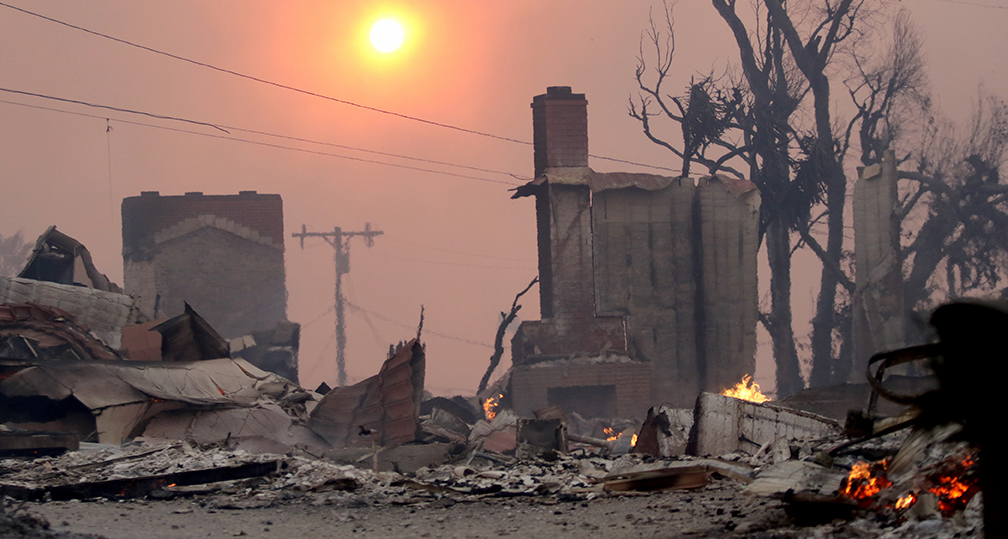
Steps To Take Before (And After) A Loss To Help With A Fire Insurance Claim
by Mark E. Hancock
The first thing to do to help with an insurance claim is to make sure you buy and maintain insurance on your home and property. Replacement cost is better. Keep the policy and any endorsements and amendments in a safe deposit box, so they don’t burn up. If your policy was destroyed, ask your insurance agent or company for a certified copy right away. Policies are different, you want to know what you had, and you want to make a claim for and receive everything that you are entitled to under your policy.
Timing
Make your claim right away. Not only may your policy pay for the costs of living somewhere else while your home is repaired or rebuilt and help pay for clothes to wear, but, practically, it may be better to be closer to the front of the line than the end. Many people were affected and made homeless by the Thomas Fire and there are only so many available rentals. You will also want to look for alternative housing, because it may be scarce and because you may be entitled, if you can find it, to live in, and have the insurer pay for, housing that is similar to what you had before the fire.
When you get your policy, read it. You want to know, from the outset, not only what coverages you had, but what your time limits are. You might have coverage not just for building and contents, but also for debris removal and trees, bushes and plant, etc. Property policies also have time limits for a lot of things, like for making proof of loss, for how long the insurance company will pay additional living expenses, for how long you have to complete construction and obtain replacement cost (assuming you had replacement cost coverage) and for how long you have to sue the insurance company – and those time limits can be fairly short. While the declaration of emergency may extend some of the limits here, you want to be clear about them and you should make sure you and your contractor know and abide by your time limits from the outset. To the extent that the insurance company might be willing to relax some of the time limits, you should work that out and get it in writing.
Documentation
Receipts are great. If you haven’t kept receipts for everything in the past, certainly keep all of them going forward. They can help prove your additional living expenses and claims under other coverages. You might want to invest in a scanner. While it is generally your burden to prove up the amount of your loss, if you don’t have receipts, look for other proof you may have. It is a good idea to video your home and your possessions in place in your home in advance of any loss to document your ownership of the items and their condition, etc. and to keep that video in your safe deposit box too. So, look for videos, photos, etc. and get going on an inventory. People who didn’t suffer a loss in these fires should look on this as a wake-up call to be ready for the future.
Keep good notes of your conversations with the claims adjustor and of the events in your case. While you may be able to request your claims file down the road, it is best if you make your own contemporaneous record of things, from your perspective.
Documentation
Give your insurance company the chance to do the right thing, but if you don’t think what they are doing is right, reasonable, or fair, or if you have questions, you certainly have the right to contact a lawyer. You definitely want to contact a lawyer immediately if the insurer demands to take your exam under oath and before you submit to one, before you invoke an appraisal clause, and/or if they send you a denial letter. You might also want to have a lawyer review your situation and any settlement offer before you accept it. You could also hire a lawyer to negotiate for you.
Remember that insurance policies are contracts that are subject to laws and regulations. This means that sometimes even if it says something in black and white, it might not be enforceable, because it violates a statute, or case law that provides how certain things are to be interpreted, or handled, etc. It also means that ambiguous provisions might be interpreted to favor you. Lawyers, especially those trained in insurance as well as in law, can certainly be valuable in these matters, especially since a person’s home is often their biggest asset. t has been this lawyer’s experience that insurance companies are well aware that “public adjustors” are not lawyers and can’t file a lawsuit against them if things aren’t handled properly and reasonably.
Mark E. Hancock is a lawyer with offices in Ventura. He is trained in insurance and previously worked as a property insurance underwriter; he also worked for an insurance defense firm before opening his own practice representing insureds.

Thomas Fire Raises Insurance, Permitting, Tax and Mortgage Issues
by Max Engelhardt
The most heartbreaking Thomas Fire statistic is two – the lives it has taken, one a retired attorney, and the other a firefighter. Virginia Pesola, 70, of Santa Paula, died in a crash while fleeing the fire. Pesola was formerly employed by the Los Angeles law firm of Burke, Williams & Sorensen, and later by the Court of Appeal in Ventura as a research attorney. Cory Iverson, 32, an Apparatus Engineer from the CALFIRE San Diego Unit, died battling the fire near Fillmore.
As the smoke clears, there are myriad legal issues. Ventura County lawyers, who are playing a vital role helping victims get back on their feet, will need to answer these questions.
What Does Our Homeowner’s Insurance Cover? How Much Compensation Will We Receive?
Coverage and Calculations
While the amount of insurance coverage will depend on the specific provisions and limits of the homeowner’s policy, there are common features.
The declarations page of the policy (usually the first page) will set forth policy limits. For the house and related real property, the coverage will typically be divided into several parts. Basic dwelling coverage includes the house and all attached structures. The other categories of real property coverage will be a percentage of the basic dwelling coverage figure. Extended dwelling coverage covers the difference between the cost of rebuilding and the fair market value as of the date of loss, and is typically 20 percent, 50 percent or 100 percent of basic dwelling coverage. Code upgrade coverage pays costs associated with bringing structures into compliance with current codes, and is often 10 percent of basic dwelling coverage. Other structures coverage will cover detached structures such as garages, sheds, and granny flats. It is also common for homeowner’s policies to provide additional coverage for trees, shrubs, and other plants, as well as debris removal.
As with the additional real property categories above, the amount of coverage for personal property loss will be a percentage of basic dwelling coverage, commonly 50 percent or 75 percent. However, there are typically limits on specified categories of personal property (e.g., a $1,500 limit on silverware or $300 for a coin collection). Full coverage for specifically identified items of particular value may be “scheduled” in the policy. Motor vehicles and tenants’ property are typically not covered.
Most homeowner’s policies also cover additional living expenses. This coverage pays for necessary temporary housing and furniture/household items rental during displacement. It is commonly limited by time (e.g., two years), by amount, or by both.
Replacement Cost Regardless
Provisions that describe the calculation of payments to the policyholder are generally found in the loss settlement section of the policy, and divided into subsections for dwelling and personal property. Two key terms in loss settlement provisions are replacement cost and actual cash value.
Replacement cost for dwellings is the cost to rebuild. Replacement cost for personal property is the cost to purchase new replacement items.
Actual cash value for dwellings is the fair market value prior to the loss. Actual cash value for personal property is the cost to purchase new replacement items, together with any necessary depreciation adjustment to account for the condition of the lost items.
Most, but not all, policies cover the replacement cost of both dwellings and personal property.
For dwellings, after the policyholder submits documentation of the structure’s features and fixtures (ideally through, for example, property records, photographs, building plans, etc.), an adjuster assigned by the carrier will negotiate the replacement cost and actual cash value.
Once replacement cost and actual cash value are agreed upon, under many policies the carrier is required to make full and prompt payment of the actual cash value, and not required to make additional payments toward replacement cost unless the insured rebuilds on the same or a different site, or purchases a replacement home. But under California Department of Insurance (DOI) rules, all policyholders with replacement cost coverage are entitled to full payment of the replacement cost regardless of whether they rebuild or replace the home.
Misinformation
Jon B. Eisenberg is a Northern California attorney who lost his home in the 1991 Oakland wildfire and who has recently been assisting survivors of the Santa Rosa fires with their insurance claims. According to Eisenberg, some adjusters are incorrectly informing California policyholders that they must rebuild the home (instead of purchasing a replacement home elsewhere) in order to cover full replacement cost. Eisenberg also reports that adjusters for the Santa Rosa disaster have been incorrectly informing policyholders that they cannot recover on code upgrade coverage unless and until they actually rebuild.
This misinformation may be due to fact that, for mass fire disasters, DOI permits insurance companies to use out-of-state adjusters on a temporary basis provided that they register with DOI and work under the supervision of a California-licensed or California insurance company. These out-of-state adjusters may not be familiar with the intricacies of California insurance law. Of course, the integrity of adjusters can vary, so ignorance may not be the only explanation. In any event, a policyholder is best-advised to ensure that his or her adjuster is duly-licensed or has the necessary authorization to adjust a California claim.
Valuation
Personal property claims will require the arduous process of listing each item of destroyed personal property, and providing estimates of date of purchase, condition when destroyed, and purchase price for replacement. Adjusters must disclose the methodology that the insurance company uses to calculate depreciation if the policyholder requests that information.
Upon determination of the replacement cost and actual cash value of the property, the insurance company must make immediate payment of the property’s actual cash value. Additional payments up to the full amount of the replacement cost will be made when the policyholder actually replaces the item. In Eisenberg’s experience with Santa Rosa claims, some adjusters have been depreciating personal property excessively, for example, by attributing “above average” condition to an item that was actually in excellent or nearly-new condition, and refusing to disclose the depreciation methodology.
For both dwelling and personal property claims, adjusters frequently undervalue replacement cost and actual cash value, and it may be cost-beneficial for the policyholder to seek assistance from a “public” adjuster or attorney to negotiate the claim.
Notwithstanding the specific provisions of their policies, survivors of the Thomas Fire should be aware that, in cases of mass fire disasters, DOI and the insurance companies have historically agreed to certain implement certain emergency relief coverage procedures, such as automatic advances for immediate living expenses and personal property losses, as well as relaxed standards for itemizing destroyed personal property.
Do We Have To Go Through The Regular Permitting Process When Rebuilding?
Officials from the City and County of Ventura are considering various approaches to handling land use entitlements and building permits for those with properties that have been affected by the Thomas Fire. Both agencies will likely consider dedicating certain resources and personnel to processing permits for those affected by the fire in order to expedite the permitting process for those properties. Also, at this point, the City has compiled, for each affected property owner, a packet for the owner that will include the property’s pertinent permitting information (e.g., past permits and entitlements, CC&Rs).
Both agencies may consider whether their existing planning and zoning standards need to be adjusted to accommodate the widespread rebuilding efforts that will need to occur. However, note that the City and County are unlikely to have much flexibility when it comes to applying the respective Building Codes, which encompass building, electrical, mechanical, energy, plumbing, and other standards.
What Is the Effect on Property Taxes and Mortgages?
Tax Reduction
If property damage from the Thomas Fire exceeds $10,000, property owners may file an application with the Ventura County Assessor’s Office for a reduction to their property tax assessment. This application must be filed within twelve months of the date of damage. Property owners must continue to pay property tax bills unless they also obtain a tax deferment (discussed below). A refund will be issued to the property owner after the property has been reassessed.
Tax Deferment
If the property damage exceeds $10,000 and the 2017-18 property taxes have yet to be paid, property owners may file a claim for tax deferment with Ventura County Assessor which will permit them to pay up until 30 days after they receive a corrected tax bill.
Proposition 13
Property owners who rebuild on the affected property will be taxed according to their original Proposition 13 base year valuation. Affected property owners may purchase or construct another replacement property in another location and still continue to enjoy their original Proposition 13 base year value if: (1) they construct or replace in Ventura County; (2) they incurred loss in property value of more than 50 percent; (3) the replacement property is similar in size and function; (4) the replacement property is purchased within five years of the date of loss; and (5) the replacement property costs 120 percent or less of the pre-loss value of the original property.
Mortgage Payments
Homeowners should continue to make their mortgage payments unless they obtain a forbearance agreement or similar payment relief from their lender. If the loan is owned by Fannie Mae or Freddie Mac, temporary forbearance may be available for three-month intervals for up to twelve months.
What Legal Resources Are Available?
The VCBA is discussing with ABA and State Bar representatives establishing a toll-free hotline exclusively for fire-related legal issues in accordance the Disaster Legal Services Program established by the ABA and FEMA.
The County of Ventura, in coordination with state and federal partners, has closed its Local Assistance Center at the Pointsettia Pavilion, but residents may still obtain fire recovery services at City and County offices.
Max Engelhardt is a litigation associate at Ferguson Case Orr Paterson, LLP in Ventura. He previously practiced law in Massachusetts.
CELEBRATION OF A RENAISSANCE JUDGE: MEMORIES OF JUDGE WILLIAM PECK
by Judge Fred Bysshe
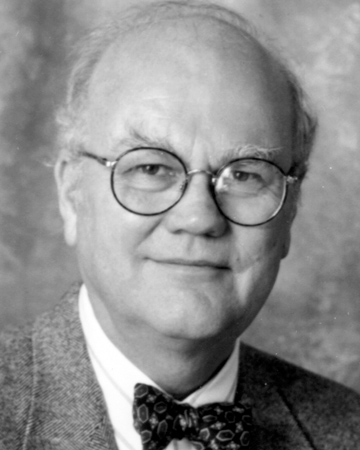 Judge Fred Bysshe spoke at the Dec. 3, 2017Celebration of Life honoring the late Judge William Peck:
Judge Fred Bysshe spoke at the Dec. 3, 2017Celebration of Life honoring the late Judge William Peck:
Bill was one of a kind and one of my dearest and most treasured friends for over 40 years.
Bill was never reluctant to express his thoughts or opinions. He never sought the camouflage of political correctness nor waited for the “right time” to express those thoughts. Whatever he was thinking you would soon learn.
He was never hesitant to engage in controversy of any kind on a topic he believed to be important.
He was a man who felt deeply and passionately – whether it was about the welfare of children, the administration of justice, or the pursuit of contemporary imperatives.
Bill didn’t suffer fools well – particularly when he believed the fools were interfering with real justice.
Bill’s was a brilliant intellect. He was a voracious reader with a broad range of interests. A man who read with discrimination, he could instantaneously cross-reference in his own head the information gleaned from his current reading with the vast base of knowledge from what he had read before. He had no need for Google. He assimilated with equal ease broad concepts and minute detail.
His interests spanned ancient to contemporary history, as well as the arts, from broad historical movements to details of Civil War battles to obscure chronicles of railroad trains and historical railway lines.
Without a pause, Bill was able to pull out some obscure fact that he had read forty years before. He and Laura, no matter the challenger, were unbeatable at Trivial Pursuit.
Bill’s interest in history was reflected in his fascinating collections, particularly his collection of clocks – clocks from multiple countries and from multiple centuries. The clocks, the chronometers, the watches – as well as his other collections, which ranged from lead soldiers and antique guns to fine art – were reflections of how Bill lived his history.
Besides his active and successful professional practices, Bill was a community leader before he took the bench, focusing on the welfare of children. He spent ten years on the Ventura Board of Education serving three terms as President, in addition to countless terms on the Boys’ and Girls’ Club Board.
He served on other boards as well, helping to build the essential underpinnings of the community’s cultural and environmental infrastructure. And after taking the bench, he became a leader on our court, serving a term as our Presiding Judge.
His contributions did not go unrecognized. He was awarded Citizen of the Year and received the Petit Award for Community Service.
One final comment. Laura had a profound effect on my long-time bachelor friend. Much of the real joy that Bill experienced in his life was the result of Bill’s mid-life marriage to Laura. Laura brought his two beloved children, Adair and Eric, into his life. Plus, she opened doors to unimagined vistas of travel. She taught Bill how to travel – and live – in style. But most important, she brought him the experience of giving and receiving love.
Bill was, quite frankly, the best of what we consider “The Renaissance Man” – an avid seeker of knowledge, an appreciator of the arts, and passionate about the social and political issues of his time. He will be greatly missed by the community and by those of us who loved him.
Frederick H. Bysshe is a Renaissance man himself, as well as a Ventura County Superior Court judge and longtime friend of Bill Peck.
JUSTICE (BEHIND THE GUY WHO) GOES FOR THE GOLD
by Wendy Lascher
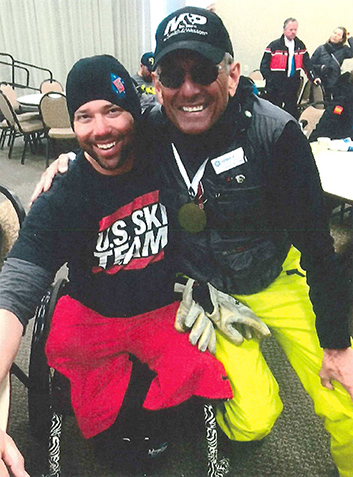 “Trent and I Were Supposed to Die” ran in the May 2008 issue of CITATIONS. There, Court of Appeal Justice Kenneth Yegan told about a scary experience in high school. Doctors diagnosed a heart condition that they thought put Yegan – captain of the varsity swim team – at risk of a fatal heart attack. Yegan lay awake nights thinking he was going to die if he fell asleep. Happily for the bench and bar, and especially lawyers who appear before Division Six, his doctors were wrong.
“Trent and I Were Supposed to Die” ran in the May 2008 issue of CITATIONS. There, Court of Appeal Justice Kenneth Yegan told about a scary experience in high school. Doctors diagnosed a heart condition that they thought put Yegan – captain of the varsity swim team – at risk of a fatal heart attack. Yegan lay awake nights thinking he was going to die if he fell asleep. Happily for the bench and bar, and especially lawyers who appear before Division Six, his doctors were wrong.
In 2006, Yegan met Trent, a twelve-year-old student at Disabled Sports Eastern Sierra. Yegan has been instructing blind and handicapped skiers at Mammoth Mountain for years. Trent, who had needed a heart transplant in his first year of life and weighed only 45 pounds when he met Yegan, was afraid of skiing too fast and having a heart attack. Yegan’s 2008 article describes the perspective an appellate justice gained about his own life as he taught a young man how to ski without being leashed to an instructor, i.e., part of what it means to be independent even when you have reasons to be afraid.
Yegan is still teaching. Warfighter Sports is a program of Disabled Sports USA. Marine Corps Sgt. Joshua Elliott, who lost both legs to an IED in Afghanistan, was one of Yegan’s first warrior students. Eight months after he woke from a medically induced coma, Elliott began monoskiing at Mammoth. He won a slalom championship at Mammoth Mountain and, by 2017, Elliott had won the U.S. Paralympics Slalom Championship title and raced in eight countries on the World Cup circuit. In March 2018, he will compete as part of the U.S. Paralympics Alpine National Team in the Paralympic Games in South Korea.
Elliott’s success, like Trent’s, shows what the drive and tenacity of a dedicated teacher can accomplish. Though Yegan is quick to point out that he is “one-tenth of one percent responsible” for Elliott’s skiing success, Elliott obviously disagrees; he insisted that Yegan wear the medal in their victory photo.
Wendy Lascher is an appellate lawyer at Ferguson Case Orr Paterson. She is co-editor of CITATIONS.
INTERNSHIP OPENS CAREER DOOR
by Greg Johnson
Johnson Moore is delighted to introduce their newest associate, Joanna Hutchins. Hutchins previously worked at Johnson Moore as a law clerk in 2014-2015 during her last year of law school at Pepperdine School of Law. At Pepperdine, she was awarded the Faculty Scholar scholarship, earned four CALI awards as well as Best Petitioner Brief in the Vincent Dalsimer Moot Court Competition, and she graduated in the top fifteen percent of her class. She was also a member of the Moot Court Board, the Dispute Resolution Law Journal, and Phi Delta Phi. After passing the bar, Hutchins spent the next two years as an associate at Nettesheim Law in Ventura, also specializing in elder abuse and neglect claims, during which she gained invaluable mentorship from founding partner Christoph Nettesheim.
Hutchins originally emigrated from Northern England with her family at the age of five. She grew up in the Bay Area and moved to Southern California upon starting college at UC Irvine. Hutchins studied criminology, law, and society, and spent her junior and senior year interning at the Public Defender’s Office. She had always intended to pursue a career in criminal law. However, her law clerk experience at Johnson Moore changed her course. “I always wanted to help people who had been victimized and give a voice to the voiceless,” says Hutchins, “but I never realized how many other opportunities there are to do that outside of criminal law.” Now, her practice focuses on elder abuse and neglect, class actions, and catastrophic personal injury.
Hutchins lives in Simi Valley with her husband, Coleton Hutchins, who is currently finishing up his MBA at Pepperdine.
Gregory L. Johnson is a founding partner at Johnson-Moore in Thousand Oaks.
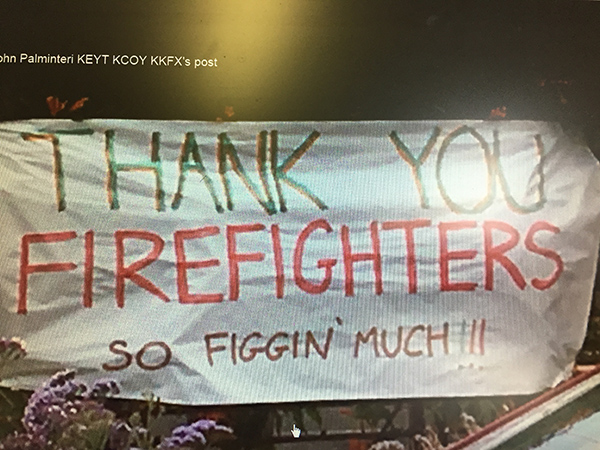
Exec’s Dot…Dot…Dot…
by Steve Henderson, M.A., CAEs
Thank you Lawyers!
I am flummoxed, cranky, nonplussed, caustic and generally irritable.
As I craft this January 2018 edition, I’ve spent eight days in voluntary evacuation and am in day three of a mandatory one. I’m not going to extol the untold tragedies of our communities. This madness is reported thoroughly via traditional journalism, social media and anecdotally. We all know someone.
This is my bitch. For a week plus now, signs have popped up all over our two-county jurisdiction extolling the heroic virtues of our brave firefighters who have come here from all over the western United States. Let me be perfectly clear (thanks President Obama), their solemn resolve to save our neighborhoods, our people and our structures is beyond comparison. Extraordinary indeed.
That said, will there ever be just one sign giving blessings to our legal community? I kinda doubt it. Firefighters are handsomely paid a salary and earn every nickel. Like other public safety officers, they also have a benefits package without parallel. Well-deserved, undoubtedly. At a gas station in Santa Barbara, I was refueling and noticed four gladiators getting some sodas and munchies. I paid. Best $20 I’ve spent in a long time.
Now let me describe a few behaviors you are not aware of, nor should you be. Most of our legal beagles operate in complete anonymity, in typically complete selflessness. Over and over, our “troopers” perform with nobility and a quietness with or without a disaster at hand. I respectfully omit their names. They wouldn’t want the press. These are our people…
A seasoned, veteran trial lawyer contacted me four days after his house burned down. “I’ve just spent hours on my insurance policy, and if it’s confusing to me, how does a non-lawyer figure this stuff out? How can I help?” he asks.
Another trial lawyer shuts down the office to open his very own well-known disaster relief operation assisting those in need. Meeting after meeting. Hour after hour. Phone calls. Emails. Texts. FB. Twitter. Snapchat.
Another attorney who works behind the scenes quietly and without adoration in the nonprofit world single-handedly opens up a kiosk in a disaster center in Ventura providing legal assistance to anyone who asks. She asks me if I can send some volunteers to staff the attempt. I tell her I’ll do what I can.
A partner in a firm loses his home overnight. His other partners and professional staff ask me how they can help. Guess where I send them? Another firm, who to the best of my knowledge had no staff in peril, asked what they could do and when can they start.
Dozens of other lawyers contacted me and said their homes were open to one and all. Folks taking in people and animals. I don’t think I ever found a spot for six chickens, but one woman attorney said she would.
On December 20, I dined in the same eatery as a VCSC judge who was also evacuated. He told me of an attorney (an ABOTA candidate BTW), who shuttered his solo practice to assist in the relief efforts in Ojai. Did it all. Legal advice, BBQ’ing or purchasing chain saws for neighbors to protect their homes.
I know fifteen lawyers who lost their homes. This does not include any staff affected. I knew all but two. We have a long way to go, but one thing for sure is, there will be no freeway overpasses or random signs acknowledging the efforts of lawyers.
I am proud to be associated with this profession. And you know what? Y’all did it for free. Pro Bono. No salary. No benefits. No free meals. No acknowledgment, except from us at your bar association. Well deserved, and you’ll do it again when the time comes.
Steve Henderson has been the executive director and chief executive officer of the bar association and its affiliated organizations since November 1990. Contact him at steve@vcba.org to help, and thanks for your continued support.
Member Benefits
Mebership Log-in
Lawyer Referral Service
Member Benefits
Mebership Log-in
Lawyer Referral Service
Member Benefits
Mebership Log-in
Lawyer Referral Service
Member Benefits
Mebership Log-in
Lawyer Referral Service
